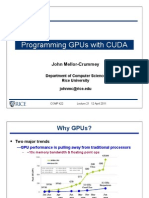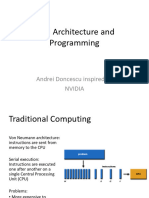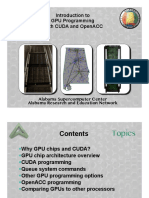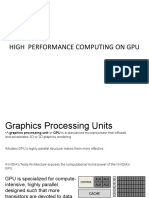0 ratings0% found this document useful (0 votes)
10 viewsGPU_Architecture_and_Programming_Lecture
Uploaded by
tabin iftakharCopyright
© © All Rights Reserved
Available Formats
Download as PPTX, PDF, TXT or read online on Scribd
0 ratings0% found this document useful (0 votes)
10 viewsGPU_Architecture_and_Programming_Lecture
Uploaded by
tabin iftakharCopyright
© © All Rights Reserved
Available Formats
Download as PPTX, PDF, TXT or read online on Scribd
You are on page 1/ 9
Introduction to GPU Architecture
• Definition of GPU (Graphics Processing Unit)
• - Originally designed for rendering graphics
but now used for general-purpose computing.
• - Massively parallel operations for tasks like
image processing and deep learning.
•
• Evolution of GPU Use in Computing
• - Transition from graphics-only to GPGPU
(General-Purpose computing on GPUs).
Detailed GPU Hardware
Architecture
• Core Components of a GPU
• - Streaming Multiprocessors (SMs) with
CUDA cores.
•
• Warp-Based Execution
• - Warp: A group of 32 threads executed
simultaneously.
•
• Memory Hierarchy
CUDA Programming Model
• What is CUDA?
• - Parallel computing platform and API for
NVIDIA GPUs.
•
• Basic Building Blocks
• - Kernels, Threads, Blocks, and Grids.
•
• Memory Management in CUDA
• - Global, Shared, and Local memory types.
OpenCL Programming Model
• Introduction to OpenCL
• - Open standard for heterogeneous
platforms (GPUs, CPUs, FPGAs).
•
• Key Concepts of OpenCL
• - Platforms, Devices, Command Queues, and
Kernels.
•
• Comparison Between CUDA and OpenCL
Parallel Computing with GPUs
• Parallel Computing Paradigms
• - Data Parallelism and Task Parallelism.
•
• Thread-Level Parallelism
• - Thousands of threads executing in parallel.
•
• Warp Scheduling and Thread Divergence
• - Divergence reduces performance.
•
Advanced Optimization Techniques
in GPU Programming
• Shared Memory Usage
• - Reducing global memory accesses.
•
• Minimizing Thread Divergence
• - Avoiding branching in warps.
•
• Occupancy Optimization
• - Maximizing active warps for performance.
•
Multi-GPU Programming and
Scaling
• Introduction to Multi-GPU Systems
• - Combining multiple GPUs for larger tasks.
•
• Programming Multi-GPU Systems
• - CUDA Streams, Unified Memory, and
NCCL.
• Challenges of Multi-GPU Programming
• - Data communication, workload
Applications of GPUs in High-
Performance Computing and
Machine Learning
• Deep Learning and Neural Networks
• - GPUs accelerate matrix multiplications in
neural networks.
•
• Scientific Simulations
• - GPUs for weather, fluid dynamics, and
molecular simulations.
•
• Cryptography and Blockchain
Future Trends in GPU Architecture
and Programming
• Next-Generation GPU Architectures
• - NVIDIA Hopper, AMD RDNA3, and AI
integration.
•
• Energy Efficiency and Performance Scaling
• - Power-efficient GPUs for exascale
computing.
•
• Heterogeneous Computing
You might also like
- AI Agents Market Size, Share & Trends _ Industry Report 2030No ratings yetAI Agents Market Size, Share & Trends _ Industry Report 203011 pages
- Programming Gpus With Cuda: John Mellor-CrummeyNo ratings yetProgramming Gpus With Cuda: John Mellor-Crummey42 pages
- GPGPU Programming With CUDA: Leandro Avila - University of Northern IowaNo ratings yetGPGPU Programming With CUDA: Leandro Avila - University of Northern Iowa29 pages
- 27th Aug - Introduction To GPGPU - Part 1No ratings yet27th Aug - Introduction To GPGPU - Part 132 pages
- Why GPU?: CS8803SC Software and Hardware Cooperative ComputingNo ratings yetWhy GPU?: CS8803SC Software and Hardware Cooperative Computing14 pages
- Introduction To GP-GPU and CUDA: High Performance Computing Center Hanoi University of Science & TechnologyNo ratings yetIntroduction To GP-GPU and CUDA: High Performance Computing Center Hanoi University of Science & Technology43 pages
- 1. Introduction — CUDA C Programming GuideNo ratings yet1. Introduction — CUDA C Programming Guide573 pages
- Introduction To Gpu Programming With Cuda and Openacc100% (1)Introduction To Gpu Programming With Cuda and Openacc40 pages
- Accelerating Large Graph Algorithms On The GPU Using CUDANo ratings yetAccelerating Large Graph Algorithms On The GPU Using CUDA12 pages
- D&I of GPU Based Image Processing On CASE ClusterNo ratings yetD&I of GPU Based Image Processing On CASE Cluster28 pages
- Introduction To Programming Massively Parallel Graphics ProcessorsNo ratings yetIntroduction To Programming Massively Parallel Graphics Processors84 pages
- Learnopencv Com Demystifying Gpu Architectures For Deep LearningNo ratings yetLearnopencv Com Demystifying Gpu Architectures For Deep Learning1 page
- Accelerating Large Graph Algorithms On The GPU Using CudaNo ratings yetAccelerating Large Graph Algorithms On The GPU Using Cuda12 pages
- Lecture 1: An Introduction To CUDA: Mike GilesNo ratings yetLecture 1: An Introduction To CUDA: Mike Giles40 pages
- NVIDIA RTX A2000 - A2000 12GB: Compact Design. Unmatched PerformanceNo ratings yetNVIDIA RTX A2000 - A2000 12GB: Compact Design. Unmatched Performance1 page
- M.Tech - Computer Vision and Image ProcessingNo ratings yetM.Tech - Computer Vision and Image Processing21 pages
- Using FFmpeg With NVIDIA GPU Hardware AccelerationNo ratings yetUsing FFmpeg With NVIDIA GPU Hardware Acceleration22 pages
- Lecture 11 Programming On Gpus Part 1 Zxu2acms60212 40212 S15lec 11 GpupdfNo ratings yetLecture 11 Programming On Gpus Part 1 Zxu2acms60212 40212 S15lec 11 Gpupdf121 pages
- Shining 3D EXScan H2 User Manual V1.2.1.0No ratings yetShining 3D EXScan H2 User Manual V1.2.1.079 pages
- DaVinci Resolve Mac Configuration Guide Sept 2013No ratings yetDaVinci Resolve Mac Configuration Guide Sept 201349 pages
- VideoEditorBusiness - Fac K ING - Info.20230524 083036.1056No ratings yetVideoEditorBusiness - Fac K ING - Info.20230524 083036.105617 pages
- Nvidia Cuda Tegra Toolkit 10.2.89: Release Notes For Development Auto 5.1.9No ratings yetNvidia Cuda Tegra Toolkit 10.2.89: Release Notes For Development Auto 5.1.98 pages
- CUDA - Wikipedia, The Free EncyclopediaNo ratings yetCUDA - Wikipedia, The Free Encyclopedia14 pages
- A Full-Scale Fluvial Flood Modelling Framework Based On A High-Performance Integrated Hydrodynamic Modelling System (HiPIMS)No ratings yetA Full-Scale Fluvial Flood Modelling Framework Based On A High-Performance Integrated Hydrodynamic Modelling System (HiPIMS)42 pages
- Tensorflow Object Detection Api Tutorial PDFNo ratings yetTensorflow Object Detection Api Tutorial PDF41 pages

























































































